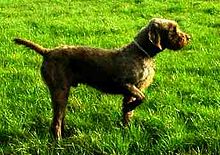Display behavior
Advertisement behavior is a term used in service dogs and dog sports . Display behavior is that form of activity that the dog carries out in order to show ( indicate ) its handler where an object (e.g. toy) is hidden. The display behavior is part of the dog's search work ( tracking , drug search , corpse search , target object search ) in which the dog finds objects based on their smell. It can be done both actively and passively .
Active display behavior
Here the dog signals by active behavior, for example by scratching or barking, where he has noticed the smell of the object.
Passive display behavior
Here the dog behaves passively, that is, he remains in a certain posture or position, for example by sitting, or in the form of "sitting down", and fixes with his nose and eyes the point where he perceived the smell of the object. In the case of passive display behavior, one also speaks of referring the object. For some service dogs such as the explosives detection dog and in some areas with the drug detection dog , passive display is particularly important in order to avoid additional dangerous situations. In this way a dog will report its find without warning the alleged drug smuggler and also serves the safety of the dog; Even with the explosives detection dog, passivity is vital for the dog and also for the dog handler. Dogs with this trained behavior are also known as passive dogs .
education
The training for a certain display behavior takes place by conditioning the behavior. Modern training methods mainly use operant conditioning . Aids are mostly food or toys. A drug sniffer dog, for example, is rewarded with its toy immediately after the desired display behavior. In an emergency, the drug found is first removed and exchanged with his toy.
Innate showing
There is also an innate display that comes from the wolves' hunting behavior. Here, too, the prey should not see the hint - therefore no barking, pawing or growling - but the hunting partner does. One paw is lifted and the dog points with its nose at the game. Many dogs show this behavior even without any training. In play behavior, raising paws reappears as a game request, but combined with jumping around and barking, the nose points to the play partner.
In the hunt, this type of showing is called pointing and a dog trained or bred for this is called a pointing dog .
literature
- Hans Joachim Swarovsky (Ed.): BI-Lexikon Hundehaltung , Leipzig 1988, ISBN 3-323-00186-9 , p. 28
Web links
- Employees with a flair and instinct to play (PDF; 845 kB) - an article on the use of dogs in the airport area with an explanation of active and passive display behavior (page 5)
